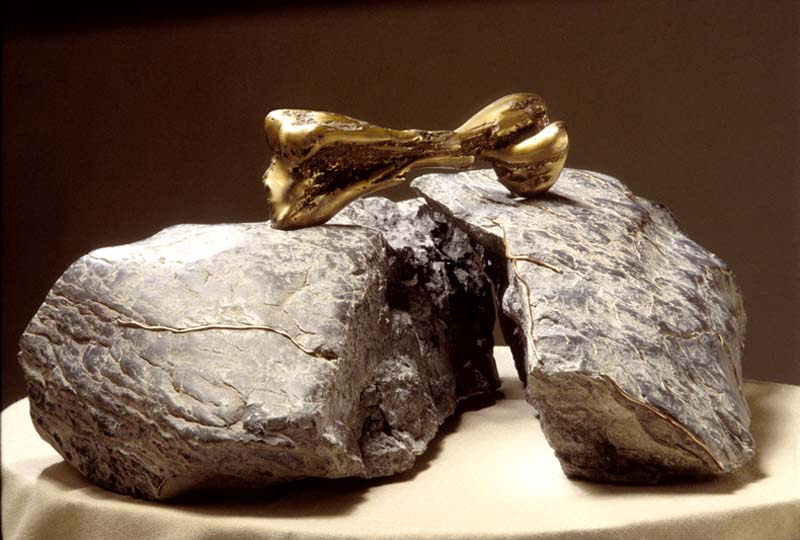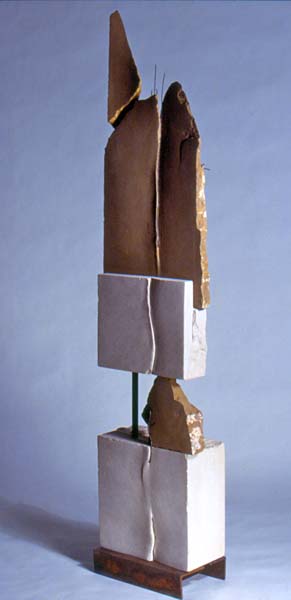Until recently, Marie Hélène Allain typically worked with one block DI stone, cutting out of it a shape that stood alone, complete in and of itself, closed and mysterious. For the past severaI years, she has been moving away from he monolithic grandeur of her work from the 70s and early‑to‑mid 80s, breaking up the stone by leaving parts of it unfinished, adding other materials to it.

Entre les lignes… is a fully realized expression of this new direction. Of these thirteen pieces, all but one incorporate metal, wood, rope, or bone, and/or mix stones of different colours and textures. Smaller, rougher, and somehow more modest and vulnerable than her earlier work, even the one piece that doesn’t fit this description, Comme un poisson hors de l’eau (of Vermont slate) is radically different from the majestic, aggressively modern minimalism for which Allain is known.
The scale is now smaller, more intimate. Whereas a good deal of Allain’s sculpture has been emphatically public ‑ heavy, dramatic, and meant to be viewed from a certain (public) distance ‑ the newer work is less overwhelming. It invites intimacy and examination from many different angles, a tracing of the connections between its various parts. As the title suggests, Allain is interested in what can only be perceived if we look beyond the surface.

Fleur de dune beautifully embodies this new focus on interiority and relationship. A vein of copper wire runs vertically through its wooden base (painted to look like a weathered boat), through a slab of polished grey‑veined white marble, and finally through a dune shaped pièce of slate to blossom in a marble flower.
Co‑vies, Résurgence, Intégration, and Racines déracinées are variations on the same theme. In each, the mixing of media illustrates cyclical renewal. In Résurgence, for instance, a small piece of wood resembling the bent head and neck of a dead bird is nestIed in a hollow of limestone. A rope winds around the limestone column, joining the small wooden ‘bird’ that looks ready to take flight to a larger, gracefully sculpted piece of wood on the other side of the rock.
Other pieces reveal a new playfulness. Raw and partly finished pieces of marble look to be jumping up (in the process of being tossed?) from a slate in the base of the whimsically titled Insalata mista Funny limestone monsters spring out of blocks of wood in Le cirque des Mal‑Rochers. But if any one piece captured the essence of the show it was Pour offrir. In direct contrast to the silent completeness of Allain’s early work, this limestone and iron construction opens itself to the viewer, revealing an interior divided into ridged segments, like an orange. It is, as its title indicates, a gift from the artist to her audience.
Clearly, Sœur Allain has entered a new phase in her « dialogue with stone » (Arts Atlantic, Winter/Spring ’80), one that is characterized by an openness and a desire to communicate more directly. It is as though she has finally managed to break open the stone that was, for so long, aloof and enigmatic.
Maria Kubacki
From Arts Atlantic no 46, Spring/Summer 1993, P. 17-18
about the exhibition Entre les lignes presented by the
Galerie d’art de l’Université de Moncton
from September 30 to October 25, 1992